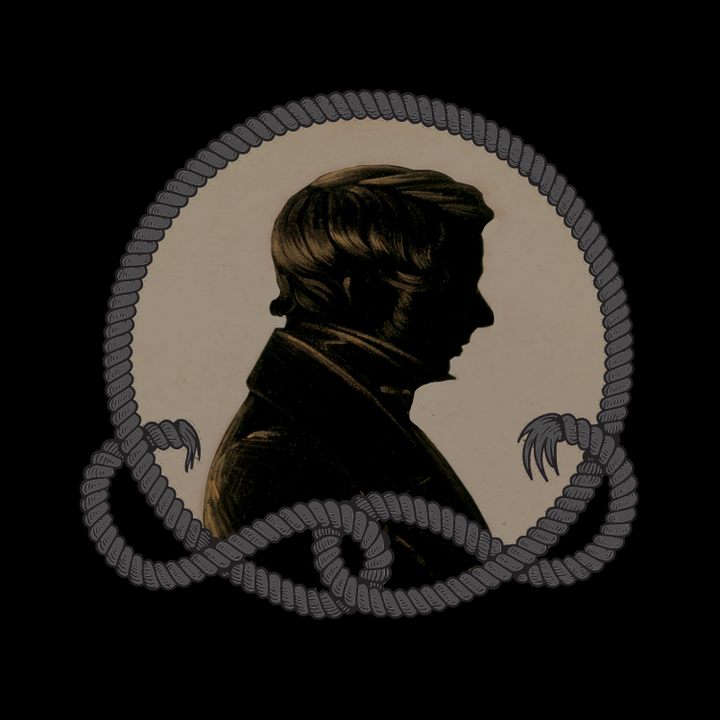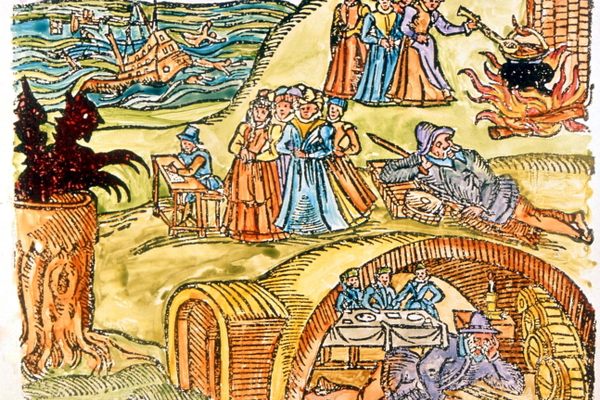
The Mystery of Monsieur de New York, Celebrity Hangman
Considered an artist of the gallows, his true identity is shrouded in myth and hyperbole.
In 1881, a mysterious story ran in the National Police Gazette, a salacious saloon and barbershop tabloid that peddled stories about a New York City increasingly riddled with crime, street gangs, and poverty. It described an unremarkable man who rides the train downtown from Harlem every morning at 9 a.m. “Very few, if any, of the many passengers … know that the quiet, ruddy faced, stout gentleman with cheerful looks who enters the train at 125th Street is George, Monsieur de New York,” the column read. The name would have struck a unique note of fear and respect across the city. Monsieur de New York was the resident executioner, and his true identity was a secret. You could be sitting next to him on the train, the Gazette suggested, and never know it.
Nearly 30 years earlier, a New York sheriff had been nursing a scotch at his favorite City Hall watering hole when “a pleasant faced young man” approached. The city’s hangman had recently resigned after his identity became so well known that he’d been both hissed and cheered on the street.
“Sheriff, I hear you’re looking for a chap to do that little job for you next Friday,” the stranger said. Public executions had been outlawed in New York for more than a decade, but the state still sentenced criminals to death at a steady clip. The man, then in his early 30s, was a butcher at the nearby market, the National Police Gazette reported, and before that he’d been a sailor with a knack for knots. In slaughterhouses he’d seen the ideal way to hoist cattle, and proposed applying the same technique to humans. Hanging, he told the sheriff, was a science. And he was determined to perfect it.

The sheriff was impressed. Before long there were two pirates on the new hangman’s docket: Nicholas Howlett and William Saul, infamous gang members who’d stolen a boat and killed a watchman. Monsieur de New York, as he would later be known, had designed an all-new gallows, with 20-foot high beams and a pulley system. Before the big reveal, he had tested, observed, and adjusted his set-up “like the manager of a new theatre just prior to the first performance,” according to the Gazette. On hanging day, he was “the master of ceremonies,” as he was for all of the many executions he would performed, according to observers. He would ascend the gallows in a black suit, carrying a staff. He pulled a cap over the head of the condemned, and then placed the rope around his neck (with the knot under the chin, rather than at the ear, in a technique he took from London). After a consoling whisper—“You needn’t fear,” or “Be a man, my boy”—he signaled to a man stationed in a closet on the other end of the pulley system to release a set of weights. The criminal would then be hoisted into the air.
Under this new overseer, “a public execution is not so terrible a thing to witness as many might suppose,” one reporter wrote after watching the hanging of an ax murderer. The newspapers gave him the name “Monsieur de New York,” and also referred to him as “George.” For decades, his true identity was fodder for columnists and crime documentarians of New York. It may never truly be known, but the clues he left behind paint an eerie composite of an engineer and an artist, a showman and a specter. He traversed New York society as a quintessential resident and haunted its dark underbelly as its executioner.
Public executions had been common in New York until 1835, when a period of social reform presented ideas about rehabilitation that centered, unironically, around practices such as solitary confinement, meant to provide contemplative time for prisoners.
By that time, “public executions had become rowdy, drunken events,” says Wilbur Miller, a Stony Brook University historian who studies crime and policing. The last words of the condemned, which had once been considered warnings for the public, were more often being used as justifications for their deeds. Pamphlets describing the lives of the criminals were widely distributed, and unprofessional hangmen made the spectacle as grisly as the crimes themselves. Predictably, people showed up. “It was meant to be a grave moral lesson for the crowd,” Miller says, “but it became a sport.”

The New York Police Department was officially created in 1845, with officers patrolling the neighborhoods where they lived, without uniforms. In the growing city, a blossoming immigrant population had ignited fear among middle-class New Yorkers. Saloons, brothels, and street gangs seemed to be on the rise. The police force was created as “a direct response to the increasing sense of disorderliness and disarray,” says Miller. The existing sheriff’s department grew, too, tasked with supervising the jails, issuing evictions, and carrying out executions. They earned money from the fees they charged the city for those services. In the case of executions, it could be thousands of dollars a head. Chaotic New York City was professionalizing and standardizing law and order.
By this time, a peculiar building in Lower Manhattan became the hub for this energy. The Halls of Justice and House of Detention, or “the Tombs,” as it was known, was a squat structure with a columned granite edifice that was built to resemble an ancient Egyptian mausoleum. Around 50,000 prisoners passed through its grand doors between 1838 to 1902, and those sentenced to death there would have to cross the “Bridge of Sighs,” which connected the prison with the gallows, over a courtyard. (Today, the Manhattan Detention Complex, built in 1983, carries the nickname “the Tombs,” the fourth Downtown building to do so.)
Though executions in the Tombs were not public affairs, audiences at a hanging could still number in the hundreds: clergy, family, and dozens of journalists and members of law enforcement. In some cases, 10 times more tickets were given out than the 200-person-capacity yard could accommodate. Those who couldn’t make it in crowded the streets and filled the windows of houses overlooking the gallows. It was still a type of public spectacle. Newspapers ran double-page spreads that spared no detail: the dropping pulse of the hanged men, the color of their fingertips, the sounds of the scene. It was into this world that Monsieur de New York stepped, plied his trade, and quickly built notoriety that spread beyond the city.

After the hanging of a murderer named Jack Reynolds in 1870, conducted by Monsieur de New York, a reporter for the Brooklyn Daily Eagle wrote: “The fact that a fellow creature is going to be executed … seems to have an unexplainable fascination for the lower orders of humanity. It looked as if the worst portions of New York had put on exhibition their choicest specimens of deteriorated manhood and womanhood.”
Public executions were still legal under federal law and Monsieur de New York took part in that spectacle as well. He got his first taste of the unquenchable enthusiasm for them on June 13, 1860, when a man named Elias Hicks was put to death for killing a ship captain and two crew members. The federal charge was piracy, and his hanging was to be held at Bedloe’s Island, which a few decades later would become home to the Statue of Liberty. A crowd of 12,000 showed up to watch in steamboats, barges, oyster sloops, yachts, and rowboats. On board, men drank beer and women shaded themselves with parasols. They traveled from Connecticut and Long Island.
“Hundreds who had never seen a person hung, and multitudes of others who would have shrunk from such a spectacle where an ordinary criminal was to suffer, clamored for ‘permits’ to look upon the last dying struggles of the man whose extraordinary career of crime had destroyed every sentiment of pity in their breasts,” The New York Times reported.
“Hang me quick—make haste,” were Hicks’s only words at the gallows. The hangman complied. “Few men have passed from earth so wholly unregretted as did this murderer and pirate,” the Times reporter wrote.

As Monsieur de New York’s renown grew, reporters referred to him with a fawning familiarity—even though they knew nothing about the man in the dark suit. An article in the Brooklyn Daily Eagle in 1865 called him “an artist in his profession; he hates to see a man die in a mean spirited manner, and never tires of lauding those who show a brave or reckless spirit to the last.”
His gallows hosted Nat Gordon, a trader caught off the coast of Cuba with a cargo of 800 enslaved Congolese people; a Confederate Army captain who’d attacked ships and rail lines; a West Point graduate who hoped to burn New York down by setting fires at a series of hotels and P.T. Barnum’s museum. The hangings often took place on Friday, “thus the week would open free from the painful scene,” a newspaper reported. The condemned were given last meals, edited their confessions, and wrote letters. One sent off locks of hair to his friends. Another had a photograph taken of himself.
“He has hung more men than any other official on the continent and can make the boast that none of his jobs ever fail,” a column in the Democrat and Chronicle in Rochester reported in 1880. The Troy Times noted his preference for Italian hemp rope and relayed that he’d never use the same piece twice. “One stretch takes the life out of it,” he told the reporter.

Soon, Monsieur de New York’s name was making news as far away as Iowa and Missouri. He fielded requests from sheriffs across America to erect their gallows and conduct their executions. Once, while he was traveling on the train back from an execution in upstate New York, a group crowded around him. Improvising a gallows on the spot, he showed off his technique and placed a noose—recently used—around the neck of a reporter. It quickly silenced the car.
Monsieur de New York even held political sway. In 1872, he threw his weight behind Ulysses Grant’s run for a second term. “The celebrated hangman, and the executioner of scores of criminals,” the Brooklyn Daily Eagle reported, was “a vehement Granite.” But still, his identity remained a mystery.
For six generations, the Samson family of Paris had held the title of official executioners of France. Dressed in blood-red coats, they killed thousands. “[U]nder special patronage of the government, the members of the race were known as Monsieur de Paris in contradistinction to such mere provincial artists that labored on the less distinguished scaffolds of Bordeaux or Orleans,” one newspaper noted. The so-called “Gentleman of Paris” was both respected and reviled. Once, as a young boy, a future Monsieur de Paris had to leave his private school when his father’s profession was discovered. One Samson executed Louis XVI; another, Marie Antoinette. The 159-year reign of the first family of execution ended in 1847.
It was just six years later that a young hangman in New York adopted a variation of the moniker. Some articles reported that he’d asked to keep his name out of the public record as a condition of his employment. An 1880 article notes that he was “determined that it should never be ‘thrown in his face.’” However, newspapers often referred to him by a name: George W. Isaacs. Many columnists believed this was a pseudonym, but not all. “It is said that the name is assumed in order to protect the family from notoriety, but I do not believe the statement,” wrote a journalist who’d interviewed Monsieur de New York himself.
Once, after a Brooklyn Daily Eagle report of a hanging in which the name George W. Isaacs was used, a man of the same name called the paper to deny the report—though perhaps not entirely convincingly. He had occasionally been a “superintendent of execution,” he said, but “did not want his children or other people, reading the Eagle, to suppose that he was ever a hangman.”
“A hangman was regarded with a kind of dread,” says Wilbur Miller, the historian. “They were not really able to mingle in society. A good hangman might be respected in a certain, very distant way, but they were marginal figures—they represented a dark side of society.”
Though both names—Monsieur de New York and George W. Isaacs—appeared in dozens of newspaper articles, his biography maintained a hazy, mythical quality. He was large and heavily built in some accounts, short and neatly dressed in others. One described him as “one of the most famous pistol shots in his day.” In others he was a butcher’s assistant, a clerk at the Fulton Market, or simply a quiet deputy sheriff. He “may be seen almost any day at the sheriff’s office, where he is always ready to converse on his dreadful art,” wrote one journalist. He was described as “an estimable man, a good neighbor, and a true friend” who attended an uptown Methodist church. He made anywhere between $75 to $250 per execution.
Perhaps all these things were true at once. An 1850s census shows that a George W. Isaacs operated a butcher’s stand in the 1850s, and another lists him as a clerk at the Fulton Market. An 1870 census finds a George W. Isaacs living in the 12th Ward of New York, which covers eastern Harlem, retired at age 59, with his wife and seven others, ages 7 to 28, living with him.

Monsieur de New York’s enthusiasm for the job was so great that he once wrote to the White House to volunteer to pay his own way to Nebraska to carry out the execution of 30 Native Americans—just so he could test a new gallows he’d designed and patented that could hang dozens of people at once. Their sentences were commuted, “much to the chagrin of the inventor,” an article reported.
One newspaper stated that he carried out 18 executions over a 30-year career, and called him “the most successful of his profession in existence.” Another counted 38 executions over the same period. But by the 1880s, neither name appeared in the papers much at all. The exploits of Monsieur de New York/George W. Isaacs were already entering the realm of legend.
In 1884, a Brooklyn Daily Eagle column called it “a popular fallacy” that George W. Isaacs had existed at all. “The fact is that there never was a man by the name of Isaacs who performed the unpleasant duty,” the article reported, claiming that one Joe Atkinson—a carpenter credited with helping design Isaacs’s signature gallows—was the true hangman, and the real Isaacs, “a man of kindly disposition and generous of heart,” was merely a deputy sheriff. While he just rigged the ropes once or twice, “this was all that he ever had to do with the distasteful duties of a hangman.”
When Atkinson was profiled in the New York World in 1888, under the headline “It Is Nice to be Hanged. Pretty women will bring you flowers and pet you,” his claims to the title of hangman didn’t sit right with readers. One wrote to complain: Atkinson was a mere carpenter, the reader said, while Isaacs was a sailor who knew how to rig pulleys and tie ropes. By then, however, Isaacs had died. “If Joe Atkinson has any conscience he will make the amends honorable and no longer walk in borrowed plumes, as the veteran hangman of New York.” Yet Atkinson continued to claim the title of New York’s hangman, while also occasionally denying that Joe Atkinson was even his real name.

In an 1890 interview, Atkinson claimed to have executed 62 people—all documented in a scrapbook he kept. “He is more repulsive than the gallows or its freight of lifeless flesh,” wrote a reporter for the Buffalo Courier Express. After a hanging, he’d work the crowd to compliment his own work. “Wasn’t that a fine job?” he’d say. “Slick I tell you. Neck broken at once. Heard it crack myself the moment the rope went off.… Electricity could do no better.”
Atkinson hardly sounded like the genteel figure the moniker was associated with. But whatever his role in the story of Monsieur de New York, Atkinson would see the last days of legal hangings. In 1887, before Isaacs had reportedly died, a man claiming the title of Monsieur de New York had emerged from his relative silence to tell a reporter from Rochester’s Democrat and Chronicle that he believed the newfangled technology for execution—the electric chair—had no chance of superseding his beloved gallows.
Two years later, a New York man named William Kemmler killed his wife with a hatchet, and early in 1890 he was sentenced to death by electricity. A lawsuit followed and the Supreme Court deemed the method constitutional. The operator of the latest state-sanctioned death machine was Edwin F. Davis, an electrician credited with building the first electric chair in 1890. New York was the first state to adopt the technology.

In 1893 an article ran in the New York World that cast the old gallows in a nostalgic light. It described a once-busy contraption that now sat among trash in a room under the Downtown Manhattan post office. “This gallows has a history,” the writer opined. “On it were put to death, before and during the civil war, murderers, pirates, slavers, guerrillas and spies.” It had been built by George W. Isaacs, the article stated. Before that, hangings had been held in Washington Square Park, overseen by a hangman who wore a sword and sash.
Like so much in New York, even death had surrendered to modernity. The old gallows had been saved by a janitor, who stopped visitors from taking pieces as souvenirs after it was decommissioned. The author seemed to hope that the device might have one last hurrah. “[T]he days of the old gibbet’s usefulness may not be ended.”
Decades later, an executioner named Robert Elliott was being dubbed by newspapers as “Monsieur de New York, Boston and Trenton.” In 1936, he’d flip on the switch of the electric chair for a fee of $150. He justified his profession “on the ground that the people who fire the furnace at the power plant or who have anything else to do with electricity are just as much to blame as he. He only turns the switch,” wrote The Chattanooga News.
The death penalty was shot down by a U.S. Supreme Court ruling in 1972, but states were allowed to reinstate it a few years later. By then, the star status of an executioner had long vanished, and with it, the identity of the Gentleman of New York.


















Follow us on Twitter to get the latest on the world's hidden wonders.
Like us on Facebook to get the latest on the world's hidden wonders.
Follow us on Twitter Like us on Facebook